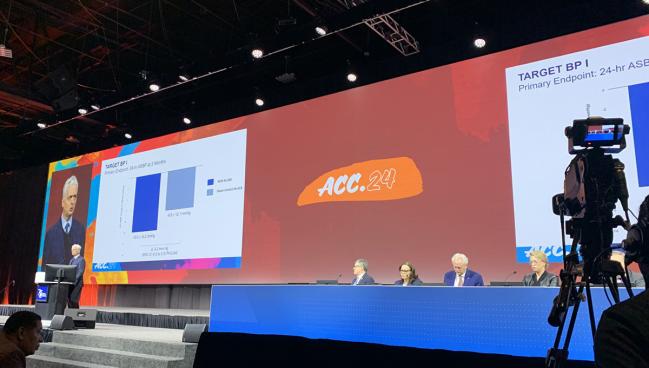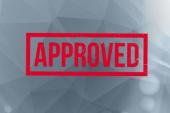TARGET BP 1: Alcohol-Based RDN Promises Single Treatment for Resistant BP
A novel approach to renal denervation led to improvements in ambulatory BP, but not office-based, in this sham-controlled trial.

ATLANTA, GA—Renal denervation using dehydrated alcohol may be an option for some patients whose blood pressure remained uncontrolled despite being on up to five antihypertensive medications, the TARGET BP 1 trial suggests.
At 3 months, 24-hour ambulatory BP was 3.2 mm Hg lower in those who underwent perivascular alcohol-mediated ablation than in a sham control group, reported David Kandzari, MD (Piedmont Heart Institute, Atlanta, GA), in a late-breaking trial session at the American College of Cardiology (ACC) 2024 Scientific Session last week. The results were simultaneously published in Circulation.
Alcohol-mediated renal denervation enters the fray at a time when two other options have recently become available in the United States. In November 2023, the US Food and Drug Administration cleared both the ultrasound-based Paradise (Recor Medical/Otsuka Medical Devices) and the radiofrequency-based Symplicity Spyral (Medtronic) renal denervation systems, both of which have indications for managing hypertension when lifestyle modification and medical therapy are not adequate.
To TCTMD, Kandzari said dehydrated alcohol is one of several new approaches being tested in this fast-growing space and may have several advantages over others in use today, chief among them the fact that it is a single targeted treatment.
The renal denervation procedure involved a mean 2.2 injections per patient of 0.6 mL dehydrated alcohol, with a maximum dose of 2.4 mL per patient delivered via catheter into the perivascular space surrounding the renal artery. Renal accessory arteries measuring 3 mm to 7 mm in diameter and supplying > 20% perfusion of the renal parenchyma also were treated in some patients, with a maximum of one accessory artery treated per side.
“Unlike ultrasound delivery, which on average is two treatments per renal artery, or radiofrequency energy, which is multiple treatments, this would be a much more, so to speak, efficient procedure,” Kandzari said. “Number two, it may be associated with less patient discomfort [by] not employing heat energy for the ablation. Number three, by a shorter period of the procedure itself there’s less resource utilization, less radiation exposure, less contrast utilization as well.”
Additionally, this type of renal denervation doesn’t require investment in equipment like ultrasound- or radiofrequency-based systems because all it uses is a catheter and dehydrated alcohol, which Kandzari noted is typically inexpensive and accessible.
TARGET BP 1 Results
For the study, researchers from 99 centers in nine countries enrolled 148 patients (mean age 56.7 years; 24% female) who were randomized to receive the alcohol renal denervation procedure and 153 patients (mean age 55.6 years; 27.5% female) who were randomized to a sham procedure consisting of diagnostic renal angiography only. Patients met enrollment criteria if they had a mean office systolic BP between 150 and 180 mm Hg as well as a mean diastolic BP of 90 mm Hg or higher. Prior to randomization, patients were required to have mean 24-hour ambulatory systolic BP between 135 and 170 mm Hg.
All must also have been on a stable regimen of two to five antihypertensive medications for at least 4 weeks and to remain on that regimen through 3 months, after which time changes were permitted if clinically indicated. Blood and urine testing to check for medication adherence was performed at baseline and 3 months.
At baseline, the mean 24-hour systolic/diastolic BP was 146.3/87.2 mm Hg in the denervation group and 146.2/87.6 mm Hg in the sham control group. The reduction in ambulatory systolic BP at 3 months favored renal denervation, with average drops in systolic BP of 10 mm Hg versus 6.8 mm Hg in the sham control group (P = 0.049).
The renal denervation group saw a reduction in office systolic BP at 3 months of 12.7 mm Hg and the sham control group saw a difference of 9.7 mm Hg (P = 0.173). Similarly, there were no significant differences between groups from baseline to 3 months relative to medication changes, nor any differences in dose titration score, defined daily dose, or medication index.
Prespecified subgroup analyses generally favored renal denervation therapy, including greater reductions observed in US versus non-US patients. Additionally, similar magnitudes of BP reduction were seen in Black versus white patients.
Major adverse events at 30 days, consisting primarily of hypotension requiring intervention or medication change, occurred in 4.7% of the renal denervation group and in no patients in the sham control group (P = 0.007).
No differences in renal function from baseline through 3 and 6 months were seen in either group.
According to Kandzari and colleagues, the relative differences in BP control between the groups are of “uncertain clinical significance,” given how well the sham control group did in lowering their BP in relation to the renal denervation group. This may be due to medication adherence or the known high degree of variability in office visit pressures, they suggest.
“Similarly, the statistically significant but still less than expected reductions in ambulatory BP that favor renal denervation may have been lessened by undocumented inconsistencies in drug adherence between groups,” the researchers note. While ambulatory BP is recognized as a more constant measure of BP burden, it too is prone to variability, they add. The researchers plan to follow the patients out to 3 years.
More Work Ahead
While more work needs to be done to inform the effectiveness of alcohol ablation, Kandzari said the ultimate test will likely be pitting it against one of the two currently approved systems.
In a press conference following the presentation, Jennifer Rymer, MD (Duke Clinical Research Institute, Durham, NC), pointed out that renal denervation therapies may offer a solution for patients who are at risk for being noncompliant for a variety of reasons, including difficulty obtaining or affording multiple antihypertensive medications.
The population studied mirrors contemporary routine clinical practice where it is not uncommon for many patients to be on five antihypertensive prescriptions or more and for many of them to be noncompliant or only partially compliant. At baseline, only a little over 40% of patients in both the renal denervation and the sham control groups of TARGET BP 1 were fully compliant, and rates of compliance in both groups increased at 3 months.
“Anyone who has taken care of these patients knows just how difficult it is [to be] compliant,” Rymer said. “We should note that patients who enter into a clinical trial are more likely to be compliant by virtue of the fact that they are getting more follow-up, and there is selection bias. So, you can certainly imagine [if you have] these types of compliance issues within a clinical trial, what it would be like in real-world practice.”
Renal denervation, including an alcohol-mediated system, “certainly” offers the potential to improve blood pressures in patients who, for whatever reason, remain noncompliant, Rymer said. TARGET BP 1, she concluded, “adds to the increasing body of evidence that we have in renal denervation and its increasing role in our treatment capabilities for patients with uncontrolled or refractory blood pressure.”
L.A. McKeown is a Senior Medical Journalist for TCTMD, the Section Editor of CV Team Forum, and Senior Medical…
Read Full BioSources
Kandzari DE, Weber MA, Pathak A, et al. Effect of alcohol-mediated renal denervation on blood pressure in the presence of antihypertensive medications: primary results from the TARGET BP I randomized clinical trial. Circulation. 2024;Epub ahead of print.
Disclosures
- Kandzari reports grant/research support from Ablative Solutions, Biotronik, Medtronic, Orbus Neich, and Teleflex; and consulting fees/honoraria from Medtronic, HyperQure, and Ablative Solutions.





Comments